Comprehensive Guide to 2x2 Wire Fencing in Agriculture
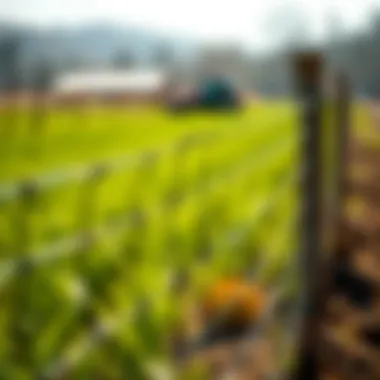
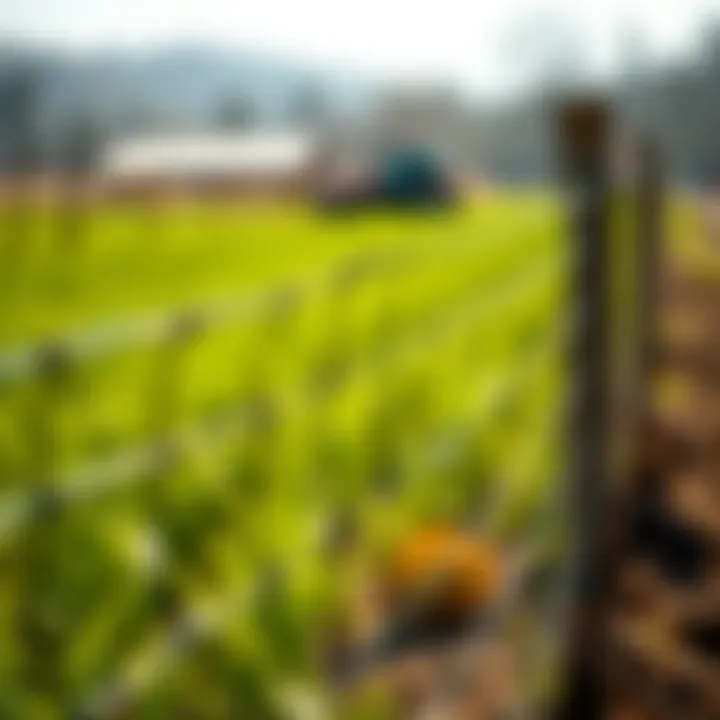
Intro
In the world of agriculture, where every farm has its own unique challenges, having a reliable barrier is essential for both security and efficiency. 2x2 wire fencing emerges as a practical solution, skillfully balancing durability and flexibility. Farmers and gardening enthusiasts alike find this type of fencing ideal for a myriad of uses. It stands as a protective wall against wildlife while simultaneously allowing for adequate airflow and sunlight. This article will walk you through the nuances of 2x2 wire fencing, diving into its construction, benefits, maintenance, and sustainability practices that cater to both seasoned farmers and newcomers to the agricultural game.
Key Insights
Overview of the Topic
2x2 wire fencing consists of vertical and horizontal wires arranged to form a grid with 2-inch by 2-inch openings. This design offers visibility and ventilation, making it superb for situations where one needs to keep animals in or out without completely obstructing views. Its applications range from livestock enclosures to garden boundaries, where versatility is key.
Importance in Agriculture/Horticulture/Agronomy
The significance of robust fencing in agriculture cannot be overstated. As farms grow, the potential for uninvited guests also rises. Here’s why 2x2 wire fencing is crucial:
- Animal Control: Prevents livestock from wandering and protects crops from being eaten by deer or other wildlife.
- Durability: It withstands harsh weather conditions better than many wooden fences, thereby cutting down maintenance costs.
- View and Airflow: Maintains an open environment, allowing for better light penetration and communication between the farm and the outside world.
"Proper fencing can mean the difference between a thriving farm and one that is constantly battling the elements."
Sustainable Practices
Eco-Friendly Techniques
Utilizing 2x2 wire fencing can align with sustainable practices when approached thoughtfully. Here are a few techniques:
- Recycling Materials: Look for recycled wire options instead of new materials.
- Natural Coatings: Using eco-friendly paints or coatings to protect the wire can extend its life without harming the environment.
Case Studies on Sustainability
Several farms have successfully implemented sustainably sourced 2x2 wire. For instance, one urban farm incorporated recycled wire fencing, reducing its carbon footprint while enhancing security. This practice not only protects their crops but also sets an example for other urban agricultural initiatives looking to lower emissions.
Tools & Resources
Essential Equipment and Technologies
Investing in the right tools could make all the difference when setting up your fence:
- Wire Cutters: Essential for shaping and attaching the wire correctly.
- Post Hole Digger: To make setting the fence posts easy and efficient.
- Level Tool: Ensures that your fence stays straight and even.
Recommended Books and Readings
To further your understanding of fencing techniques and agricultural practices, consider reading:
- "Fences for Pasture and Garden" by Greg Judy
- "The New Organic Grower" by Eliot Coleman
Additionally, peruse websites like USDA.gov or Agriculture and Food Research Initiative for an abundance of resources available for farmers and agricultural experts.
Understanding 2x2 Wire Fencing
2x2 wire fencing serves as a fundamental element in agricultural practices, providing both practical benefits and innovative solutions for a variety of farming scenarios. Understanding this fencing style is crucial for farmers and gardening enthusiasts alike, who are looking to optimize their enclosures for livestock or crops. The simplicity of its design blends functionality with adaptability, making it a prominent choice across the agricultural landscape.
Definition and Characteristics
2x2 wire fencing derives its name from the dimensions of its mesh openings. Typically made with galvanized steel, this kind of fence is structured with wires crossing at regular intervals, forming 2-inch by 2-inch squares. The materials used make it not only sturdy but also resistant to rust and corrosion, which is essential for longevity in various environmental conditions. The fencing comes in a variety of gauges, catering to different levels of security and durability based on the application it is intended for.
Key characteristics include:
- Mesh Size: The 2x2 square openings provide ample visibility while ensuring that small animals cannot pass through.
- Material Strength: Galvanized steel wires ensure resistance against external factors and forces.
- Ease of Installation: Often lightweight, this fencing can be installed using basic tools and minimal fuel expense.
- Versatility: It can be used for a variety of applications from livestock pens to garden borders.
Historical Background
The evolution of 2x2 wire fencing traces back to the early 20th century when farmers began experimenting with varied fencing structures to protect their livestock and crops. During this time, traditional wooden fences were being replaced due to cost and maintenance associated challenges. Wire fencing began gaining momentum, particularly galvanized versions, thanks to advances in metal treatment processes that made it substantially more durable.
As agricultural practices evolved with technology through the years, the demand for efficient and sustainable materials saw the rise of 2x2 wire fencing as a staple. By offering an economical solution that is also easy to maintain, farmers started adopting it across continents, influencing fencing norms beyond just agriculture to include gardens, parks, and other landscapes.
Common Uses in Agriculture
In agricultural settings, the applications of 2x2 wire fencing can be as varied as they are numerous. This fencing type isn't just a physical barrier; it works as a protective shield for both crops and livestock. Here are some common uses:
- Livestock Enclosures: Ideal for securing sheep, goats, or chickens, the mesh holes prevent escape while allowing proper ventilation.
- Crop Protection: Guard against deer and other larger wildlife that may threaten crops, making it a practical choice around fields.
- Garden Boundaries: Used to create visible boundaries in gardens, while also deterring small pests from entering.
- Horticultural Structures: Support climbing plants by acting as a trellis structure while maintaining space.
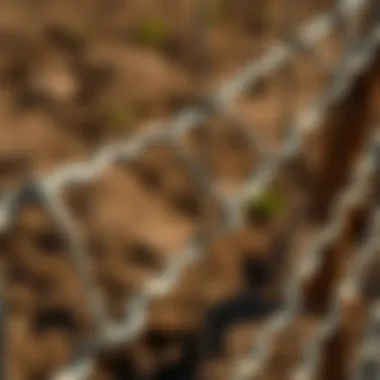
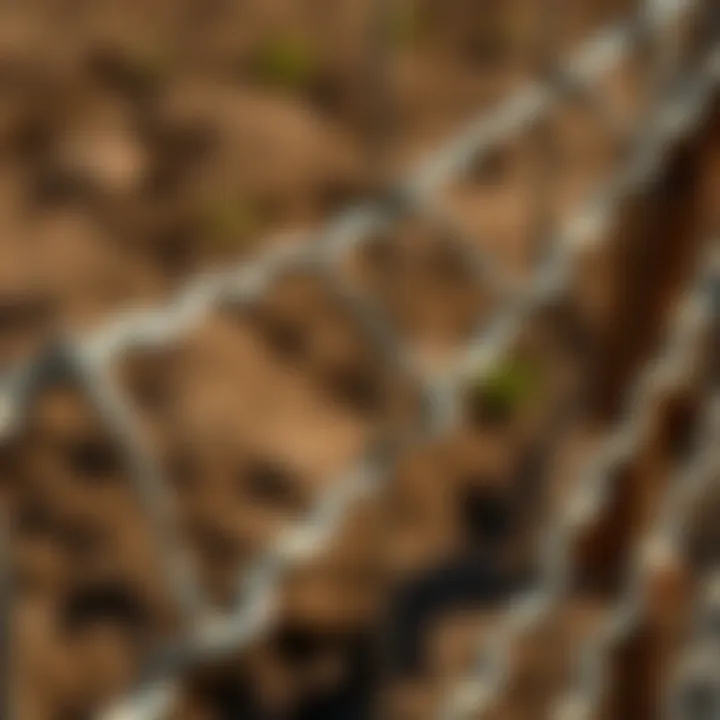
"The right fence is more than just a barrier; it’s the silent guardian of our fields and farms."
By delving deeply into understanding 2x2 wire fencing, agriculturalists can maximize their capabilities and enhance their relationships with crops and livestock. This foundational awareness paves the way for evaluating the type of fencing that suits their specific needs.
Types of 2x2 Wire Fencing
When focusing on the various types of 2x2 wire fencing, it’s vital to understand the nuances that differentiate one option from another. Choosing the right type of fencing not only has practical implications but also affects overall project durability and costs. These wire fencing types are foundational for any agricultural setting, be it for keeping livestock or defining garden plots. Knowing their specific characteristics, benefits, and potential limitations lays the groundwork for making informed decisions.
Galvanized Wire Options
Galvanized wire fencing is particularly popular in agricultural settings for good reason. The wire undergoes a galvanization process, which involves coating it with zinc to prevent rust and corrosion. This makes it highly suitable for outdoor environments where it's subjected to the elements. Some farmers have reported that choosing galvanized wire has led to up to 20 years of durability, depending on local weather conditions and soil properties.
Benefits of galvanized wire include:
- Longevity: The zinc coating significantly extends the lifespan of the wire, ensuring that it remains functional over the years.
- Strength: Galvanized wire exhibits exceptional strength, making it ideal for containing livestock and serving as a robust border for crops.
- Low Maintenance: With a lesser chance of rusting, there is reduced need for regular maintenance, thereby saving both time and effort.
However, the initial cost might be higher than uncoated options. Nonetheless, many find that the investment pays off in the long run.
PVC Coated Wire
On the other hand, PVC coated wire fencing provides an alternative for those who prioritize aesthetics alongside functionality. It consists of a galvanized wire that is further coated with a layer of PVC, offering a vibrant finish that can complement various landscapes. Farmers often choose this option when they are looking to integrate fencing harmoniously into their garden or orchard.
Advantages of PVC coated wire include:
- Visual Appeal: Its range of colors allows for easy customization to match the surroundings, making it aesthetically pleasing.
- Corrosion Resistance: While galvanized wire protects against rust, the PVC adds another layer of defense, safeguarding the fencing from scratches and environmental damage.
However, it’s important to note that PVC coatings can be susceptible to wear from extreme temperatures, and replacement might be required sooner than with standard galvanized wire.
Comparison of Materials
When weighing galvanized wire versus PVC coated wire, several factors should be considered:
- Cost:
- Durability:
- Application:
- Galvanized wire typically has a lower upfront cost, but PVC coated options might be more favorable for those considering long-term investments.
- In harsher climate conditions, galvanized wire tends to outlast PVC coated varieties. However, the latter offers enhanced visual appeal.
- For high-traffic areas, galvanized wire is often a more pragmatic choice. PVC might suit decorative settings better but could require more frequent inspections for wear.
Benefits of Using 2x2 Wire Fencing
When it comes to agricultural practices, making the right fencing choices can turn a good farm into a great one. The importance of 2x2 wire fencing in this context can't be overstated. This type of fencing offers a combination of characteristics highly valued in agricultural settings: strength, flexibility, and cost-effectiveness. Let’s get into the real meat of it—why opting for 2x2 wire fencing could be a game-changer for your farming operations.
Durability and Longevity
One of the prime attributes of 2x2 wire fencing is its durability. Made from sturdy materials, this kind of fencing can withstand the elements—a critical factor in agricultural environments where wind, rain, and UV exposure can lead to faster deterioration of inferior materials.
Farmers often face unexpected challenges and disturbances. Whether it's livestock pushing against the fence or seasonal changes that can test the mettle of your barriers, having a durable fence in place is non-negotiable.
- Corrosion Resistance: Most 2x2 wire is galvanized, which means it undergoes a protective process that makes it resistant to rust and corrosion. This leads to a longer life span, often exceeding decades in some cases.
- Impact Resistance: The strength of these wires allows them to remain intact even when loaded under pressure. That’s a plus when you have livestock that might be a bit rambunctious or other animals that might try to breach your defenses.
By focusing on fences that stand the test of time, you're inherently investing in the integrity of your operation—a detail that shouldn't be taken lightly.
Cost-Effectiveness
When you’re farming, expenses can creep up faster than you can say "budgeting." 2x2 wire fencing often comes at a price that won’t make you gasp.
Here’s why this fencing makes sense financially:
- Initial Investment: While the upfront cost may appear slightly higher than some alternatives, when you evaluate it against the longevity and lower maintenance requirements, it’s a bargain.
- Maintenance Costs: With robust materials, you won’t find yourself spending a fortune on repairs every year. In fact, a good quality fence might just need an occasional inspection rather than persistent upkeep.
- Insurance Benefits: Having reliable fencing may also lead to lower insurance premiums because your livestock and crops are better protected against theft or escape.
Ultimately, a cost-effective investment isn’t just about what you shell out at the first go. It’s about the kickback you get over time. Think of it as a long-term savings plan that pays off by protecting your investment in both crops and livestock.
Versatility in Application
Another advantage of 2x2 wire fencing is its versatility. It's not a one-trick pony. Whether you're enclosing a vast orchard, creating grazing areas for your livestock, or even setting up a community garden, this fencing adapts without breaking a sweat.
- Multi-Purpose Use: You can use 2x2 wire fencing in numerous configurations, suiting various agricultural needs. Think about temporary setups for rotational grazing or even protecting fragile flowerbeds from unwelcome critters.
- Compatibility: These fences can work alongside other materials, like posts or barbed wire, allowing you to create custom fencing solutions that are tailored to your specific needs.
- Aesthetic Appeal: It doesn’t hurt if the fencing looks good, too. With options like PVC coating, farmers can achieve a cleaner, more polished look for their properties, adding value beyond mere functionality.
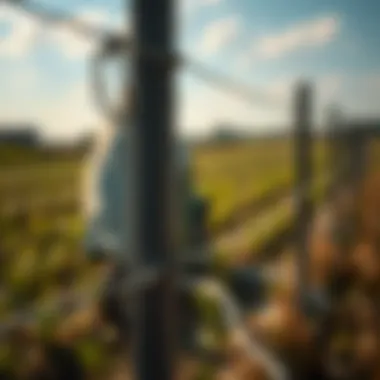
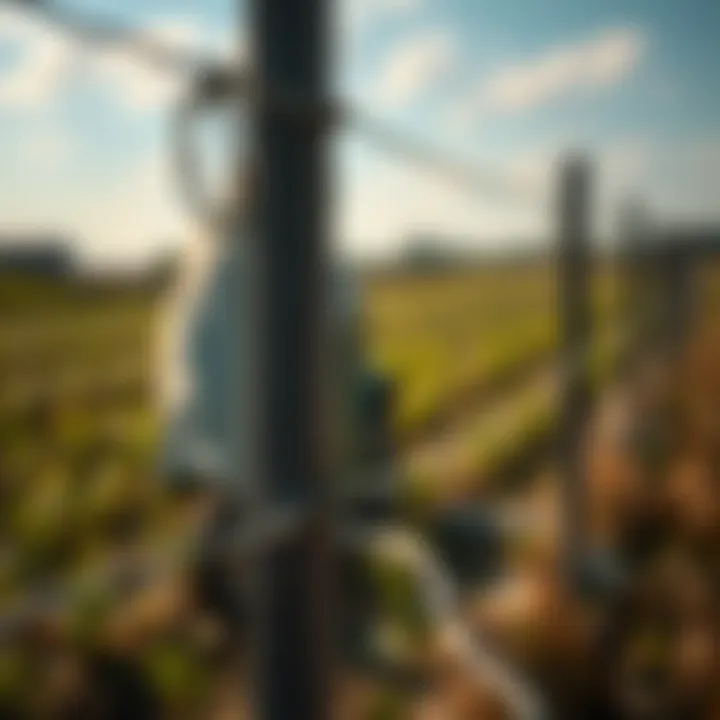
"A good fence makes good neighbors," they say. When using 2x2 wire fencing, you might find yourself greeting them more often since your livestock won't wander into someone's property.
In summary, the advantages of using 2x2 wire fencing blend seamlessly into the agricultural landscape, creating both a solid practical foundation and a framework for future growth. Whether you're drawn to its durability, cost-effectiveness, or versatility, one thing is clear—this fencing solution is worth considering when planning your agricultural endeavors.
Installation Process of 2x2 Wire Fencing
The installation process of 2x2 wire fencing plays a crucial role in the overall effectiveness of agricultural fencing solutions. It’s not just about driving posts into the ground or stringing wire between them; the methodical approach ensures durability, functionality, and safety for the livestock and crops involved. A well-installed fence prevents unwanted visitors, both human and animal, and supports the overall success of farm operations.
Materials Required
Before embarking on the installation journey, it's vital to gather all necessary materials. This not only saves time but also ensures that the installation is seamless. Here’s a list of materials to consider:
- 2x2 Wire Fencing: The primary material, typically available in rolls, providing strength and flexibility.
- Fence Posts: Made from wood, metal, or recycled materials, these are essential for providing structure to the fence.
- Post Caps: To prevent moisture from entering the post ends which can lead to rotting.
- Concrete (optional): For extra stability, especially in areas with loose soil.
- Tools: Including a post hole digger, wire cutters, pliers, and a tensioning tool.
- Gate Hardware: If you plan on adding a gate, ensure you have hinges, latches, and perhaps a metal frame.
Collecting these items in advance minimizes interruptions during installation.
Step-by-Step Installation Guide
Installing 2x2 wire fencing involves a series of clear steps that, when executed properly, lead to a strong and functional barrier. Here’s a comprehensive guide:
- Plan Your Fence Line: Survey the area to establish where the fence will go. Mark the line using stakes or spray paint. It’s important to consider any terrain features or existing structures.
- Set the Posts:
- Attach the Wire: Starting from one end, unroll the 2x2 wire fencing along the length of the fence. Fix it to each post using wire clips or tensioners, making sure it remains tight, but not overly so, to allow for some movement.
- Secure the Bottom and Top: If necessary, attach multiple rows of fencing to provide strength and prevent animals from burrowing underneath.
- Install Gate Frames: If your design includes a gate, set up the metal frame now. Ensure it’s at the appropriate height and securely attached to the posts.
- Final Inspection: Once installed, walk along the fence to check for areas needing adjustment or additional tension. This is also the time to check for sharp wire ends or anything that could pose a hazard.
- Dig holes for the posts, typically about two feet deep and spaced eight to ten feet apart.
- Place the post in the hole and either backfill with soil or use concrete for added support. Ensure the posts are level and straight.
Common Mistakes to Avoid
Even the most seasoned farmers can slip up during installation. Here are some pitfalls to sidestep:
- Neglecting Soil Conditions: Failing to assess the soil can lead to unstable posts. Always evaluate the ground; if it's too soft, consider concrete for support.
- Improper Post Alignment: If posts aren’t level and straight, the wire will sag and may weaken over time.
- Skipping the Planning Stage: It may seem tedious, but marking out the fence line and planning can save a world of hassle later on.
- Not Using Enough Tension: Wire fencing must be taut. Insufficient tension will lead to sagging and could compromise the fence's integrity.
- Ignoring Local Regulations: Some areas have regulations about fencing materials and heights. Always check your state or local guidelines to ensure compliance.
By adhering to this structured approach, farmers can install 2x2 wire fencing effectively, ensuring it withstands the test of time and serves its purpose well in agricultural settings. For further information on fencing regulations, you can visit the local agricultural extensions or check this resource.
"A fence is not just a boundary. It’s a line of safety, protection, and care for farmed life."
Ensuring that the installation process is thorough pays dividends in the long run, supporting both the land and the livelihood it nurtures.
Maintenance Strategies for 2x2 Wire Fencing
Maintaining 2x2 wire fencing is not just a chore; it’s an essential practice that can significantly prolong the life of the fence and ensure its effectiveness in protecting crops and livestock. A well-maintained fence saves time and money in the long run, while also fostering a safe environment for agricultural activities. Regular upkeep enhances the durability of the materials used and can prevent potential hazards, ensuring both the fence's integrity and the safety of the farm.
Regular Inspection Routines
Implementing a regular inspection routine is the cornerstone of maintaining 2x2 wire fencing. Farmers should schedule inspections at least once every season, or more frequently if the area experiences severe weather or animal disturbances. The following steps can aid in the inspection process:
- Visual Assessment: Walk along the entire length of the fence, looking for obvious signs of wear, such as rusting or bending.
- Tension Check: Ensure that the wire is taut. Loose wires can lead to sagging, which can compromise the fence's purpose.
- Post Condition: Examine the fence posts for stability. Any posts that show signs of rot or damage should be replaced promptly.
By catching small problems before they escalate, farmers can save themselves a hefty repair bill down the road. An ounce of prevention is worth a pound of cure, and in fencing, this couldn’t be truer.
Repair Techniques
When repairs become necessary, knowing the right techniques is crucial. Here are some basic repair methods to keep your 2x2 wire fencing in tip-top shape:
- Re-tensioning: If you find sections with sagging wire, re-tensioning the wire should fix the issue. This involves releasing the tension, straightening the wire, and then tightening it back with a tensioning tool.
- Wire Splicing: For any severed sections, splice the wire back together by using a simple knot method or by utilizing wire clamps. Be sure to leave no sharp edges that may pose risks to animals.
- Post Replacement: If the wooden posts are rotting or broken, replace them with new posts. Use concrete to secure the base of the new posts for stability.
These repairs can often be completed by hand, reducing downtime for the fence and restoring its functionality swiftly.
Weatherproofing Tactics
Weatherproofing is an often-overlooked aspect of maintaining 2x2 wire fencing, but it’s essential for ensuring longevity in diverse climate conditions. Here are some effective tactics to bolster weather resistance:
- Choosing the Right Coating: Opt for galvanized wire, which offers increased resistance against rust and corrosion. If using PVC coated wire, ensure it is of high quality to withstand harsh conditions.
- Regular Cleaning: Removing dirt and debris from the wire helps to prevent rust formation. A simple wash with soap and water during inspections can go a long way.
- Protecting Wooden Components: Treat wooden posts with weather-resistant stains or sealants to prevent water damage and decay. Regularly check for cracked or split wood and replace posts as needed.
By following these weatherproofing strategies, farmers can ensure that their fencing holds up against wind, rain, and sun, keeping their agricultural environment secure and functional.
"An ounce of prevention is worth a pound of cure.” - Benjamin Franklin
Case Studies and Real-Life Applications
Understanding 2x2 wire fencing isn’t merely an academic exercise; real-world application offers crucial insights that illuminate its practicality. Case studies allow for a deeper exploration of the fencing's performance in various environments and conditions. By diving into tangible examples, we underscore its relevance in diverse agricultural settings. Here, we explore how farmers leverage this fencing type and various community projects that also benefit from its utility, and not least, consider the crucial environmental implications.
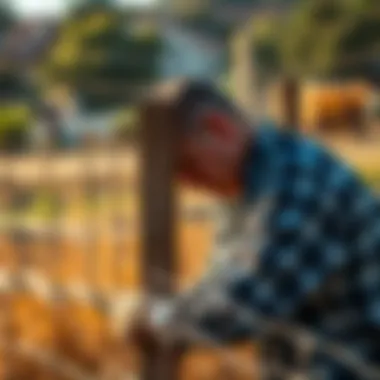

Farmers' Experiences
Many farmers who have installed 2x2 wire fencing often share their personal journeys, highlighting either success or hardships. Take John, a corn farmer in Illinois. He installed 2x2 wire fencing around his fields as an effort to keep the deer out. Initially feeling skeptical about his investment, John found that the fencing not only worked wonders in protecting his crops, but also created a boundary that helped in managing his livestock better. The deer would have found his crops a tasty treat, but the fence kept them at bay, ultimately leading to a noticeable increase in his yield.
In contrast, Sarah, a sheep farmer in Oregon, initially chose 2x2 wire fencing for its affordability and swift installation. However, she learned that not all products are equal. A cheap option left her flocks vulnerable when strong winds knocked down sections, prompting her to invest in a more durable choice later on. This highlights the significant impact of quality material on functionality.
"Fencing isn’t just about keeping things in or out; it’s about creating a safe environment for both crops and livestock," Sarah stated in a discussion on farming forums.
Community Gardening Projects
Urban agriculture has seen a rising wave of community gardening initiatives, leveraging 2x2 wire fencing as a means to not only define spaces but also secure them. Take, for instance, the community garden in Albuquerque, New Mexico. Initiated by residents keen on sustainable living, the 2x2 wire fencing provided a sturdy perimeter that deterred potential threats, like stray pets or roaming wildlife.
The gardeners noted that their produce thrived thanks to the secure environment fostered by the fence. Moreover, the visibility of this modern fencing style attracted new members to the gardening initiative, showcasing a blend of aesthetics and functionality. It is a classic case of how a simple structure can turn into a community gathering point, encouraging local collaboration in food production and sustainability.
Here are some benefits noted by these projects:
- Safety and Security: Protecting plants and encouraging participation.
- Aesthetic Appeal: Enhancing the visibility and attractiveness of the garden.
- Engagement: Attracting new community members who may otherwise not participate.
Environmental Impact Considerations
The environmental considerations associated with 2x2 wire fencing are vital for any agricultural setting. With the ongoing emphasis on sustainability, many farmers and community projects are exploring eco-friendly options for fencing materials. For instance, some farms have begun utilizing recycled steel in their wire fencing, which not only helps reduce waste but also often offers improved durability compared to traditional options.
Moreover, by implementing fencing in a responsible manner, one can mitigate negative impacts on local wildlife. Thoughtful placement of fencing can create buffer zones, helping animals navigate their habitats while protecting crops simultaneously. The symbiotic relationship between agriculture and local wildlife conservation is growing increasingly important.
In a world where environmental concerns are paramount, practicing sustainable fencing not only demonstrates a farmer's commitment to the land but also enhances their community's agricultural resilience. It’s a small step that can lead to greater ecological balance and sustainable farming practices.
Regulatory and Safety Standards
When discussing the application of 2x2 wire fencing within agricultural settings, understanding regulatory and safety standards is paramount. These standards serve as a crucial foundation for ensuring the well-being of both the land and individuals working with or around the fencing. Farmers must navigate these regulations diligently to avoid potential fines, enhance safety, and promote sustainable practices. Moreover, adhering to these guidelines can streamline operations and reduce liability risks.
Local Regulations and Guidelines
The landscape of local regulations can differ significantly from one region to another. Therefore, it’s vital for farmers to familiarize themselves with the specific guidelines that pertain to their area. Local zoning laws often dictate where and how fences can be installed, including considerations of height, materials allowed, and setbacks from property boundaries.
- Check with local authorities to make sure you are compliant with planning and building codes.
- Environmental protections must also be considered, especially if the fencing is near wildlife habitats or water sources. For instance, some areas may restrict the use of certain materials that could potentially affect local ecosystems.
- Usage of electronic fencing in conjunction with 2x2 wire may also be governed by local laws. Ensure any electric components are in line with local safety codes to prevent accidents.
Understanding these nuances can not only save a farmer from legal troubles but can also ensure that the structure installed contributes positively to the farm's dynamics.
Safety Measures During Installation
Installation of 2x2 wire fencing isn't merely about hammering in posts and unrolling wire. It requires careful consideration of safety measures to protect everyone involved in the process. It’s all about being smart to prevent possible accidents. Below are some recommended safety strategies:
- Personal Protective Equipment (PPE): Always wear the appropriate gear such as gloves, safety goggles, and sturdy footwear. These can prevent injuries from sharp wire or heavy materials.
- Proper Tools: Ensure that all tools utilized during installation are in good working condition. Broken equipment can lead to serious accidents.
- Environmental Awareness: Being mindful of your surroundings is key. Watch out for buried cables or water lines when digging fence posts to avoid any surprises.
- Teamwork: Never attempt to install fencing alone if it can be avoided. Having a partner can make a significant difference, especially when dealing with heavier components or managing uncooperative materials.
- Worker Training: If you employ workers for installation, ensure they are trained in safe practices. Familiarizing them with the tools and emergency procedures can make all the difference in maintaining a safe work environment.
Safety should never take a backseat. Efficient and responsible installation goes hand in hand with compliance to local regulations and awareness of safety standards.
In summary, the effective installation and maintenance of 2x2 wire fencing hinge upon understanding and implementing regulatory frameworks and safety protocols. Taking these standards seriously not only fosters a safer working environment but also contributes to the broader community and natural landscapes in which these agricultural practices take root.
Future Trends in Fencing Materials
The world of fencing materials is evolving, much like the agricultural practices it supports. As farmers and garden lovers continuously seek improvements in efficiency and sustainability, keeping up with the trends in fencing materials becomes essential. Future trends in fencing materials not only enhance the durability and functionality of installations but also align with eco-friendly practices that are becoming paramount in today’s agricultural landscape. Understanding these trends is vital for anyone involved in farming, as it can significantly influence productivity and sustainability.
Innovations in Wire Technology
The landscape of wire fencing is witnessing some exciting advancements. New wire technologies are coming onto the scene with a focus on strength, longevity, and ease of use. One notable innovation is the development of coated wire varieties that resist corrosion and wear, thereby extending the life of fencing installations in harsh environmental conditions.
In addition, manufacturers are now producing high-tensile wire that uses a unique alloying process, giving it improved strength without the added weight. This means farmers can construct stronger fences using less material, resulting in time and cost savings. These innovations not only ensure a sturdier barrier for livestock but also simplify installation processes.
Another emerging trend is the introduction of smart fencing solutions. These include integrated technology that monitors conditions, alerts owners to breaches, or provides insights on livestock behavior. This shift towards intelligent systems is reshaping how farmers manage their properties.
Sustainability and Eco-Friendly Options
The push towards sustainability is clear in the innovations emerging in fencing materials. Today’s agricultural landscape is not just about productivity; it’s about doing so while being kind to the planet. Eco-friendly options are gaining momentum as farmers become aware of their environmental impact.
One trend is the use of recycled materials in the production of fencing products. For instance, some companies are creating fencing solutions from reclaimed plastics or metals. This not only reduces waste but also lowers the carbon footprint associated with manufacturing new materials.
Furthermore, natural materials such as wood are being sourced from sustainably managed forests. Traditional wooden fencing offers aesthetic appeal while boosting sustainability efforts, especially when pressed into service as part of a larger permaculture setup.
Farmers can also explore bio-degradable fencing options made from plant-based materials that decompose harmlessly over time. Aligning with sustainable practices can boost a farm's image and attract consumers more interested in environmentally friendly products.
"Investing in sustainable materials isn’t just about compliance; it’s a commitment to fostering an environment for future generations."
Ending
These future trends in fencing materials stand as a testament to the agricultural field's resilience and adaptation. Whether through advaced wire technologies or sustainable practices, the evolution behind fencing materials is closely tied to the broader agricultural goals of sustainability and efficiency. Farmers are encouraged to explore these innovations and make choices that not only serve their current needs but also prioritize the health of the land for the future.
For further reading on agricultural sustainability and fencing options, visit the USDA, the National Sustainable Agriculture Coalition, or read articles listed on Wikipedia.







